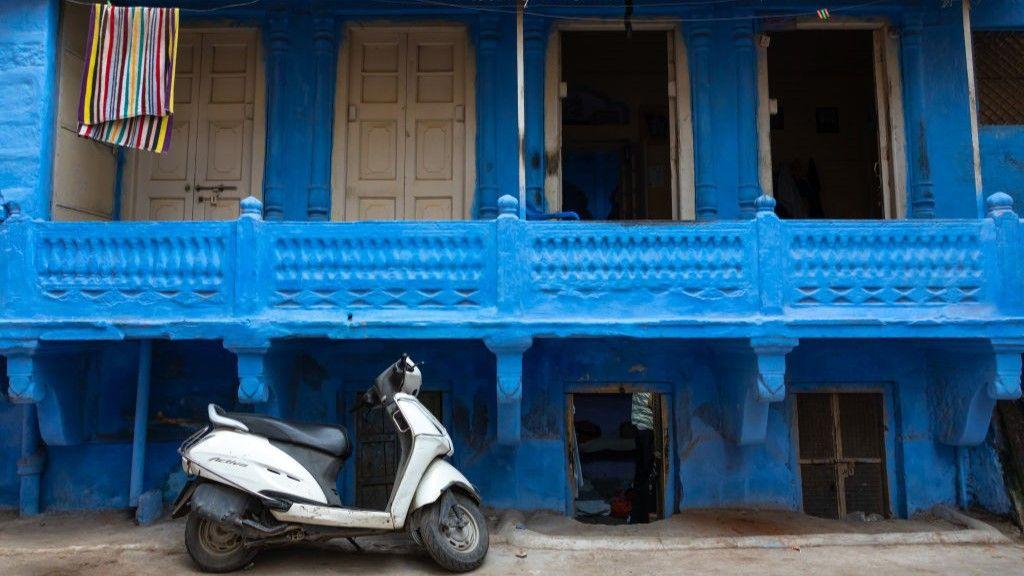Brahmapuri, a neighborhood in the historic city of Jodhpur in India, is renowned for its striking blue-colored homes nestled under the shadows of the ancient Mehrangarh Fort. Founded in 1459 by the Rajput king Rao Jodha, Jodhpur boasts a rich history encapsulated within its fortified walls. Over the centuries, Brahmapuri has become a symbol of the city’s identity, often referred to as the “Blue City” due to its azure-hued residences that attract global tourists. According to Esther Christine Schmidt, an assistant professor at the Jindal School of Art and Architecture, the tradition of painting homes blue only became prevalent in the 17th century, evolving from a sociocultural marker of upper-caste Brahmin families. These families adopted the color as a representation of their piety within the Hindu caste system, akin to the similar practice observed among Jewish communities in Chefchaouen, Morocco.
The color blue, rich in cultural significance, also served practical purposes. Its presence in Brahmapuri can be traced back to the area’s access to natural indigo, sourced from nearby Bayana, a significant indigo-producing center. The natural indigo mixed with traditional lime plaster proved effective in cooling the homes during the searing heat of Jodhpur’s climate while adding an aesthetic element that enhanced the neighborhood’s appeal. However, over the years, there has been a noticeable decline in the prevalence of the iconic blue shade. Factors such as rising temperatures, loss of traditional building techniques, and urbanization contribute to this phenomenon. Studies indicate that Jodhpur’s average temperature has decreased from 37.5°C in the 1950s to 38.5°C in 2016, necessitating residents to gravitate toward modern amenities like air conditioning, thereby diminishing the need for natural cooling solutions that the blue homes once provided.
Moreover, the operational shift towards contemporary building materials and designs poses a risk to the traditional blue facade of Brahmapuri. Many new constructions favor concrete, which does not absorb blue pigments well. This transformation exacerbates the urban heat island effect, where areas with darker materials reflect more heat and light, intensifying the discomfort for the residents. Currently, it is estimated that half of the approximately 33,000 homes in Brahmapuri still maintain their distinctive blue hues, showcasing an ongoing tension between modernization and heritage preservation. Civil engineer Aditya Dave recounts how rising costs of natural indigo and changing priorities have led many residents to choose alternative finishes, which in turn affects the neighborhood’s authenticity.
Adding to this complexity, community members express a sense of loss regarding Jodhpur’s unique identity. Local merchant Deepak Soni, who is actively involved in restoration efforts, notes the embarrassment felt by residents when international tourists visit expecting to see the famous blue homes, only to find areas that have lost this iconic hue. Soni has taken decisive steps toward heritage preservation, initiating discussions with local authorities and rallying homeowners since 2019 to repaint their houses blue, reviving their former glory. Through his efforts, about 3,000 homeowners have committed to restoring the blue color on their homes, significantly contributing to the aesthetic and historical significance of Brahmapuri.
Soni’s initiatives exemplify a broader movement among residents to sustain Jodhpur’s identity and prevent further dilution of its rich cultural heritage. He emphasizes the importance of public awareness, urging locals to recognize the significance of their traditional architecture and community spirit. Without a concerted effort to care for and preserve their heritage, there is a risk of alienating tourists and losing the city’s unique essence. His advocacy extends further as he collaborates with governmental bodies to consider applying lime plaster techniques, ensuring homes are not only blue but also cool and functional in the face of rising temperatures.
Ultimately, Brahmapuri’s future lies in the balance between modernization and heritage conservation. The commitment of local activists, like Deepak Soni, alongside the community’s collective will, is essential in maintaining the historical and cultural integrity of this beloved neighborhood. As Jodhpur navigates the challenges posed by climate change and urban expansion, the hope to retain the unique blue charm of Brahmapuri remains a testament to the resilience and dedication of its residents. By embracing both traditional practices and innovations in sustainable architecture, Brahmapuri can continue to flourish as a vibrant center of culture and history, preserving its identity for generations to come.

